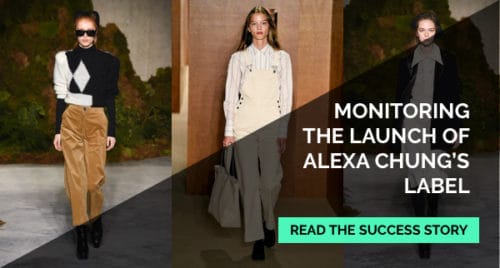Chiara Ferragni.
Kylie Jenner.
Leandra Medine.
Alexa Chung.
What do these influencers have in common?
After witnessing their success with partnerships with other brands, influencers around the world are taking the leap and launching their own labels. Digital entrepreneur, Chiara Ferragni, led the way with the launch of her Chiara Ferragni Collection in 2013 and has been followed by the likes of Kylie Jenner of Kylie Cosmetics, Leandra Medine of Man Repeller, as well as Alexa Chung’s brand, ALEXACHUNG.
But is a stellar Instagram following all these influencers need for success? What really goes into the launch of their labels? A stunning collection of course, but the true key lies in a solid marketing and communications strategy to build buzz around the debut. Alexa Chung’s team not only built a successful strategy but were able to understand just how effective their marketing actions were. Here is how:
Launching in May 2017, ALEXACHUNG’s marketing and communication plan was initiated roughly a year before the contemporary ready-to-wear line was even scheduled to debut. Alexa Chung’s brand leveraged media assets by providing Business of Fashion with an exclusive announcement, that described the inspiration behind the brand, as well as Chung’s motivations to “have the freedom to make her own world, without someone else’s brand’s brief to stick to.”
In an almost ‘drip-fed’ marketing strategy, the brand then launched a cinematic style teaser video unveiling ALEXACHUNG’s logo, before holding a star-studded runway show in London, with other influencers in attendance such as Pixie Geldof and Daisy Lowe. This anticipation build-up coupled with the buzz created by the differentiation in marketing tactics led to the success of the brand launch.
See how the PR team tracked media coverage surrounding the launch:
But…how did the ALEXACHUNG team know it was a success?
They monitored media coverage before and after the release
Whilst most brands track their media coverage based on the volume of mentions, it’s important to dig a little deeper, in order to unlock potential opportunities. Tracking both the quality of the media sources that cover a brand launch as well as which regions are talking about your brand can be just as valuable as evaluating the number of sources talking about you.
They identified who was writing about their brand
The first thing that catches most people’s attention when tracking media mentions, is who exactly is talking about the brand. The value that these mentions hold can increase validity for a brand, depending on their reputation and readership. Online publications like Business of Fashion and WWD alongside traditional media sources like Vogue and Harper’s Bazaar, tend to carry more weight than some regional or niche fashion publications. However, a niche publication could also help you convert new target customers, so it is important to track who your sources are to predict how your collection might be received.
ALEXACHUNG’s launch was covered by Vogue.com an astonishing 63 times across 11 of their online platforms, which told the brand that Vogue’s audience would likely be interested in the upcoming collection. Knowing which publications were generating buzz and were receptive to the launch, also allowed brands like Alexa Chung’s to make decisions such as who to send samples to once the collection is out – as these publications were likely to also feature the collection when it debuted.
They look into the regions where they are generating buzz
Another crucial factor that is often overlooked when tracking media mentions, is where that content is actually coming from. The launch of Alexa Chung’s brand not only generated coverage in somewhat predictable regions such as fashion hubs like the US, UK, France, and Italy but also saw significant coverage from publications in Spain, Portugal, Germany, and the Netherlands.
Through examining the global buzz they were generating, ALEXACHUNG opened a hugely successful pop-up shop in Tokyo which was followed by 12 more across Asia. As a result of noticing these global market openings in more niche locations, the brand was able to expand and conquer as well as create more global partnerships and unlock new customers. By just evaluating where media content is coming from, potentially valuable markets that were previously unconsidered can be detected and tapped in to.
View this post on Instagram
All thanks to technology.
Traditionally, brands tend to manually track and qualify coverage, which can be time-consuming, especially if you have to scout out, buy and then flick through physical print copies for one mention. It’s also not 100% certain that you’re going to be able to track every single mention, which is potentially risky if coverage from different regions comes up that you wouldn’t think to look at. By integrating a software-based system, dedicated to monitoring media mentions, brands can combat the risks associated with manual tracking (and free up precious time). Platforms dedicated to this also go beyond tracking and recording, as they can also filter out coverage from an influencer’s personal account versus their label’s account, separating the Alexa Chung from the ALEXACHUNG.
And, using media monitoring platforms aren’t just useful for new brands. Whether you’ve just launched or have been in action for a while, it’s always vital to see what kind of buzz you’re generating so that you can integrate this information into your marketing tactics.
Want to learn more from ALEXACHUNG’s brand launch? You can read the full case study below:

